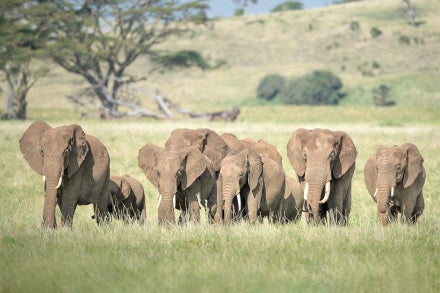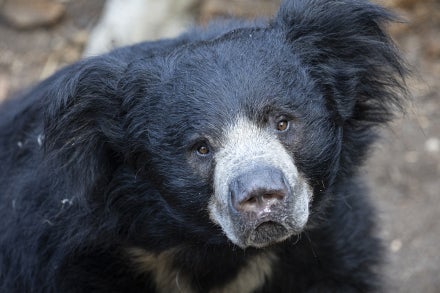
A school of fish darting in perfect unison, a litter of puppies snuggling together, baby ducks waddling behind their mother in a neat row. Across the animal kingdom, family connections come in countless forms. Whether they’re sprawling groups or small circles, these structures of belonging also reveal a fascinating mosaic of survival strategies. While every animal family is unique, they all share one purpose: to help their species thrive.
For zebras, living in a herd means more eyes, ears, and noses to detect threats like lions and hyenas.
It Takes a Village
Whether it’s a flock, pod, or brood, many animals thrive in a group, and for good reason—herd living offers many advantages.
Sometimes it’s protection: when a zebra is injured by a predator, the herd will circle their fallen friend and protect it with powerful kicks, bites, and head butts.
Sometimes it’s teamwork: meerkats share responsibilities like standing sentry or foraging for grubs so the whole group can benefit from the collective efforts.
And sometimes it’s caretaking: African wild dogs feeding on a hunt return to the den to regurgitate food for the ill, the old, and the very young.
For species like these, having a friend (or a hundred) keeps everyone safe, strong, and successful.
Bring a group along when you visit zebras at the San Diego Zoo Safari Park and meerkats at the San Diego Zoo.
By bringing her infant along while exploring, a mother lemur bonds with her baby and shows it around their African island habitat.
Mama Knows Best
Many herds are matriarchal, meaning a mother or other female leads the group.
Lemurs are led by an alpha female and her relatives who search for food and defend their territory—all while carrying babies on their backs.
A queen bee earns her title as the whole colony works to support her and her reproduction, and they dutifully follow her to a new hive location when nearby resources become scarce.
For elephants, which we work to protect through our Savanna and African Forest Conservation Hubs, the oldest, most experienced female maintains the herd’s social network and ensures its survival. As seen during the recent earthquake in Southern California, when the adults formed an “alert circle” around the babies, expertise and leadership are essential skills for any mom in charge.
Elephants also demonstrate the “grandmother effect”: when an elder is present to share their years of experience and knowledge, the health of the group increases. An older elephant can show the herd how to pick the best plants, navigate steep terrain, and find water sources she visited years prior.
Killer whales exhibit the effect too, as a post-reproductive female can care for babies during younger moms’ mating seasons to ensure the calves receive attentive and uninterrupted care.
Swing by to check out lemur dynamics at Africa Rocks at the Zoo, and don’t miss a chance to observe these relationships in the herd at the Safari Park’s Elephant Valley.
Groups of male turkeys puff their feathers, fan their tails, and scrape their wings on the ground to attract nearby females for their brother.
Sibling Solidarity
Sometimes wildlife look to their family peers for support and camaraderie as they explore the wide world around them.
For beavers and Asian short-clawed otters, older siblings help raise newborns so the adults can focus on finding food and guarding their den.
As lions grow up, siblings break off and start new families together. While most people are familiar with a pride of lions, those are only formed by sisters—brothers create their own group called a coalition as they search for a new family to join.
Similarly, wild turkey brothers leave the nest and stay together for life, and the younger toms even act as “wingmen” to help the top turkey find mates. Talk about brotherhood!
We care for lions every day through our Savanna Conservation Hub and right here in San Diego. Feel proud of the difference you make when you visit these big cats at both the Zoo and the Safari Park.
The flamingo fathers at the Safari Park kept their chick fed with crop milk, a nutritious substance produced in their digestive tracts.
Like One of Their Own
Parents come from many places. Alloparenting, where animals care for children that aren’t biologically their own, is not only helpful but can often be lifesaving.
When a young mountain gorilla loses its parent, the troop will raise the little one with such dedication that it maintains its social standing and likelihood of survival.
Red squirrel populations may be spread across the northern hemisphere, but they know how to keep family near: a female squirrel may adopt an orphaned baby if they’re closely related.
And for northern elephant seals, it’s common for a pup to get separated from its parent on their crowded Pacific beaches. Hope is not lost though: another mother who has lost her own child may nurse and protect the young one as if it were her own.
Even when animals can’t have their own children, they may find ways to be loving and devoted caretakers. Monogamous, same-sex penguin couples have been known to follow their innate parenting instincts by trying to incubate egg-shaped rocks. They get their chance at parenthood when they take in an egg that has been abandoned, hatching it and keeping the baby safe and warm.
Recently at the Safari Park, wildlife care specialists gave mated male lesser flamingos an egg from another pair already raising a second hatchling. The pink pair were naturals and attended to the chick’s needs as they alternated dad duty.
While we work to protect marine life through our Oceans Conservation Hub, you can visit the flamingos for yourself at the Safari Park, or hop over to the penguin colony at the Zoo’s Africa Rocks.
A beehive can house 80,000 bees or more, but no matter how many roommates they have, every bee works to support the queen as she lays more eggs.
Wildlife show us that family is about more than just lineage—it flourishes with connection, care, and community. Next time you visit the Zoo or Safari Park, take a moment to admire these incredible animal groups and the unique ways they support each other. No matter what shape it takes, family is a force that helps species thrive in wondrous ways.
As ally for wildlife, you’re part of a family of conservationists creating a world where all life thrives. Discover how we’re protecting wildlife groups of all shapes and sizes through our eight Conservation Hubs.
Photo credits: turkey photo: Gerald Corsi/E+/Getty Images; bee photo: StockSeller_ukr/iStock /Getty Images Plus.









